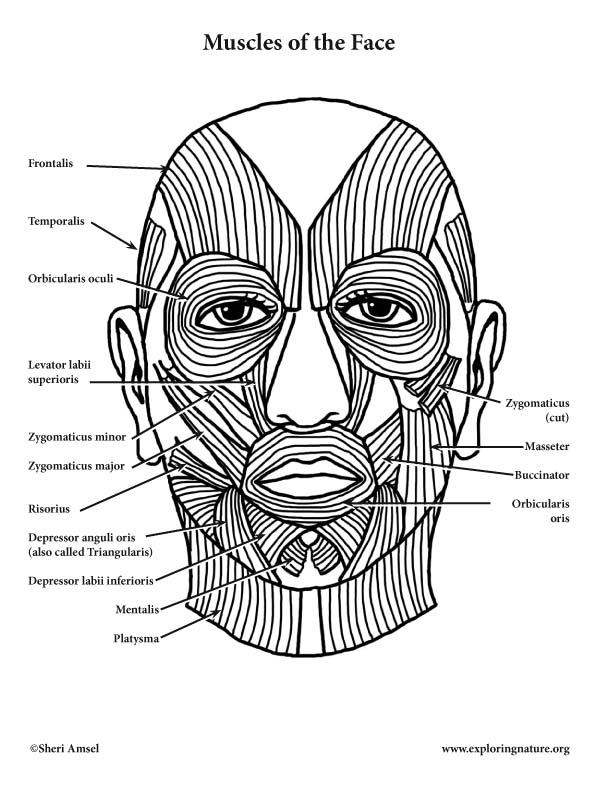

Muscles of Facial Expression
Blood Supply: External Carotid Artery
Motor Innervation: Facial Nerve (Vll)
Sensory Innervation: Trigeminal Nerve (V)
1) Frontalis (worry muscle):
a. Actions: Raises eyebrows, furrows brow
b. Innervation: Facial Nerve (Vll)
c. Origin: from galea aponeurotica
d. Insertion: to skin above the eyebrows
2) Occipitalis – not shown on diagram (in back):
a. Actions: pulls scalp back
b. Innervation: Facial Nerve (Vll)
c. Origin: from posterior back of skull
d. Insertion: to anteriorly with the galea aponeurotica
3) Orbicularis oculi (sphincter muscle of the eyelid):
a. Actions: squinting, closes eye, crowsfeet, eye bags
b. Innervation: Facial Nerve (Vll)
c. Origin/Insertion: surrounds rim of orbit
4) Zygomaticus (major and minor) (smiling muscle):
a. Actions: raises corners of mouth upward
b. Innervation: Facial Nerve (Vll)
c. Origin: from corners of mouth
d. Insertion: to zygomatic bone
Risorius:
a. Actions: pulls laps laterally (helps with smiling)
b. Innervation: Facial Nerve (Vll)
c. Origin: from fascia of masseter
d. Insertion: to skin at corner of mouth
5) Orbicularis oris (kissing muscle):
a. Actions: closes lips, purses and protrudes lips
b. Innervation: Facial Nerve (Vll)
c. Origin/Insertion: surrounds mouth
6) Mentalis (pouting muscle):
a. Actions: protrudes lower lip, wrinkles chin
b. Innervation: Facial Nerve (Vll)
c. Origin: v-shaped pair from point of chin
d. Insertion: to Orbicularis oris
7) Buccinator:
a. Actions: compresses cheeks for whistling, blowing and sucking (infants), holds food between teeth during chewing
b. Innervation: Facial Nerve (Vll)
c. Origin: from Orbicularis oris across cheek
d. Insertion: back to maxilla and mandible by molars
8) Platysma (grimace muscle):
a. Actions: helps depress mandible
b. Innervation: Facial Nerve (Vll)
c. Origin: from mandible
d. Insertion: to skin over clavicle
9) Levator labii superioris:
a. Actions: opens the lips and flares the nostrils
b. Innervation: Facial Nerve (Vll)
c. Origin: from the zygomatic arch and infraorbital margin of the maxilla
d. Insertion: to the skin and muscle of the upper lip
10 ) Depressor anguli oris or Triangularis (frowning muscle):
a. Actions: pulls corners of the mouth down
b. Innervation: Facial Nerve (Vll)
c. Origin: from corners of mouth
d. Insertion: to mandible
11) Depressor labii inferioris (pouting muscle):
a. Actions: pulls lower lip down down
b. Innervation: Facial Nerve (Vll)
c. Origin: from mandible
d. Insertion: to the skin and muscle of lower lip
Clinical Significance: Bell’s Palsy (Facial Nerve by ear)
Symptoms:
Muscles of Mastication (Chewing)
Blood Supply: Maxillary Artery (off External Carotid Artery)
Innervation: Trigeminal Nerve (V)
1) Masseter:
a. Actions: closes (elevates) mandible (powerful for chewing)
b. Innervation: Trigeminal Nerve (V)
c. Origin: from angle of mandible (cheek)
d. Insertion: to zygomatic arch (lateral jaw)
2) Temporalis:
a. Actions: closes (elevates) mandible and retracts jaw
b. Innervation: Trigeminal Nerve (V)
c. Origin: from carotid process
d. Insertion: to temporal bone
3) Medial pterygoid (deep below zygomatic arch) – not shown on diagram:
a. Actions: closes (elevates) mandible, side to side movement
b. Innervation: Trigeminal Nerve (V)
c. Origin: from sphenoid bone, maxilla and palatine bone
d. Insertion: to medial (deep) mandible surface near angle
4) Lateral pterygoid (deep below zygomatic arch) – not shown on diagram:
a. Actions: protrudes mandible, side to side grinding, stabilizes temporal-mandibular joint
b. Innervation: Trigeminal Nerve (V)
c. Origin: from sphenoid bone
d. Insertion: to the condyle of the mandible and the TMJ capsule
5) Buccinator: though a muscle of facial expression, it also helps with chewing.
___________________________________________________________________________________________
Use this study tool to learn the Muscles of the Face: Color the Muscles of the Face
Assess your knowlege of the Muscles of the Face: Label the Muscles of the Face
______________________________________________________________________
